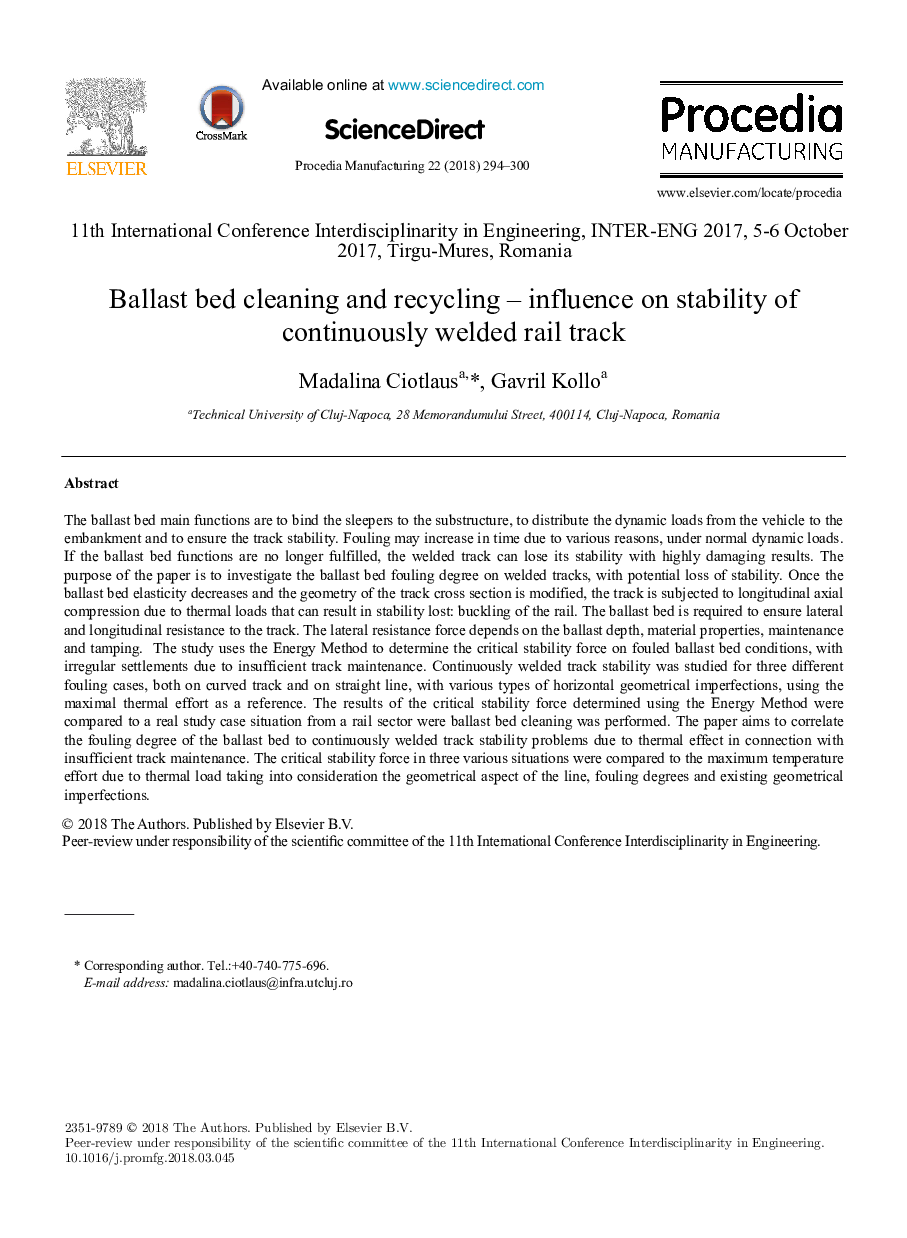| کد مقاله | کد نشریه | سال انتشار | مقاله انگلیسی | نسخه تمام متن |
|---|---|---|---|---|
| 7544993 | 1489593 | 2018 | 7 صفحه PDF | دانلود رایگان |
عنوان انگلیسی مقاله ISI
Ballast bed cleaning and recycling - influence on stability of continuously welded rail track
ترجمه فارسی عنوان
تمیز کردن و بازیافت بطری بستر - تاثیر در ثبات مسیر راه آهن به طور مداوم جوش داده شده است
دانلود مقاله + سفارش ترجمه
دانلود مقاله ISI انگلیسی
رایگان برای ایرانیان
کلمات کلیدی
ترجمه چکیده
تابع اصلی بستر باطری برای اتصال تخته ها به زیر ساخت، توزیع بارهای پویا از وسیله نقلیه به خاکستری و اطمینان از ثبات مسیر است. با توجه به دلایل مختلف، بارگذاری در زمان بارگیری پویای نرمال ممکن است در زمان افزایش یابد. اگر عملکرد تخت روکش دار دیگر برآورده نشوند، مسیر جوش می تواند ثبات خود را با نتایج بسیار مخرب از دست بدهد. هدف مقاله این است که درجه ضعف بستر توپ را در مسیرهای جوش داده شده با ضعف بالقوه ثبات بررسی کنیم. هنگامی که کشش بستر بالاست کاهش می یابد و هندسه قسمت عبور مسیر اصلاح می شود، مسیر به دلیل بارهای حرارتی که می تواند باعث از دست رفتن ثبات می شود، بوسیله فشرده سازی محوری طول می کشد: خم شدن راه آهن. تخت بالستیک برای اطمینان از مقاومت جانبی و طولی در مسیر، لازم است. نیروی مقاومت جانبی به عمق بلستر، خواص مواد، نگهداری و تمیز کردن بستگی دارد. این مطالعه با استفاده از روش انرژی برای تعیین نیروی پایداری بحرانی در شرایط تنفس فالوده، با حل و فصل نامنظم ناشی از تعمیر و نگهداری مسیر ناکافی است. پایداری مسیر پیوسته جوش داده شده برای سه مورد مختلف سقوط، هر دو در مسیر منحنی و در خط مستقیم، با انواع مختلف ناهمواری های هندسی، با استفاده از حداکثر تلاش حرارتی به عنوان یک مرجع. نتایج نیروی بحرانی بحرانی تعیین شده با استفاده از روش انرژی با یک مورد واقعی مورد مطالعه از یک بخش ریلی مقایسه شد. هدف مقاله این است که درجه ریزش بستر بلستر را به علت اثرات حرارتی در ارتباط با تعمیر و نگهداری مسیر ناکافی، به طور پیوسته جوش داده شود. نیروی بحرانی بحرانی در سه موقعیت مختلف با حداکثر تلاش درجه حرارت به دلیل بار حرارتی با توجه به جنبه های هندسی خط، درجه ریزش و نقص های هندسی موجود مقایسه شد.
موضوعات مرتبط
مهندسی و علوم پایه
سایر رشته های مهندسی
مهندسی صنعتی و تولید
چکیده انگلیسی
The ballast bed main functions are to bind the sleepers to the substructure, to distribute the dynamic loads from the vehicle to the embankment and to ensure the track stability. Fouling may increase in time due to various reasons, under normal dynamic loads. If the ballast bed functions are no longer fulfilled, the welded track can lose its stability with highly damaging results. The purpose of the paper is to investigate the ballast bed fouling degree on welded tracks, with potential loss of stability. Once the ballast bed elasticity decreases and the geometry of the track cross section is modified, the track is subjected to longitudinal axial compression due to thermal loads that can result in stability lost: buckling of the rail. The ballast bed is required to ensure lateral and longitudinal resistance to the track. The lateral resistance force depends on the ballast depth, material properties, maintenance and tamping. The study uses the Energy Method to determine the critical stability force on fouled ballast bed conditions, with irregular settlements due to insufficient track maintenance. Continuously welded track stability was studied for three different fouling cases, both on curved track and on straight line, with various types of horizontal geometrical imperfections, using the maximal thermal effort as a reference. The results of the critical stability force determined using the Energy Method were compared to a real study case situation from a rail sector were ballast bed cleaning was performed. The paper aims to correlate the fouling degree of the ballast bed to continuously welded track stability problems due to thermal effect in connection with insufficient track maintenance. The critical stability force in three various situations were compared to the maximum temperature effort due to thermal load taking into consideration the geometrical aspect of the line, fouling degrees and existing geometrical imperfections.
ناشر
Database: Elsevier - ScienceDirect (ساینس دایرکت)
Journal: Procedia Manufacturing - Volume 22, 2018, Pages 294-300
Journal: Procedia Manufacturing - Volume 22, 2018, Pages 294-300
نویسندگان
Madalina Ciotlaus, Gavril Kollo,
